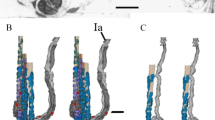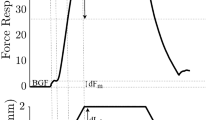Summary
The existence of beta innervation in many cat muscles raises the possibility that spindle afferent discharge will excite beta motoneurons, augmenting spindle afferent discharge and thereby closing a positive feedback loop. In order to evaluate the strength of such a loop through beta motoneurons and muscle spindles, the stretch responses of muscle spindle afferents from medial gastrocnemius (MG) and soleus (SOL) muscles were studied in decerebrated cats before and after dorsal root section. If a positive feedback loop were operational, the spindle afferent stretch response should be diminished following dorsal root section by an amount related to the magnitude of positive feedback. After dorsal root section, the static positional sensitivities of our MG spindle afferent sample were significantly reduced for 72% (13/18, p < 0.05) of the afferents, and dynamic rate/length slopes were decreased for 88% (8/9) of a subset of the afferents studied. Similar reductions for 6 afferents from SOL were not found. To apportion these afferent changes to reflex excitation of either gamma or beta motoneurons, we recorded the stretch responses of gamma and alpha-type fibers in the same preparation. (We assume that the population of alpha-type fibers includes beta fibers). In keeping with other reports, alpha fibers were much more responsive to stretch than gamma fibers. The mean positional sensitivity for alpha fibers (1.29 ± 0.92 pps/mm, n = 15) was greater (p < 0.05) than that of gamma fibers (0.49 ± 0.93 pps/mm, n = 18). Because of these differences in sensitivity, beta motoneurons are more likely (than gamma motoneurons) to be involved in a positive feedback loop, although some gamma contribution is also likely. Using equations based on a beta position regulating scheme, differences in spindle positional sensitivity were used to estimate beta loop gain. The average loop gain was estimated to be 0.41 (n = 18). The contribution of such a beta configuration to reducing the sensitivity of muscle to changes in load and muscle properties is evaluated.
Similar content being viewed by others
References
Arbuthnott ER, Ballard KJ, Boyd IA, Gladden MH, Sutherland FI (1982) The ultrastructure of cat fusimotor endings and their relationship to foci of sarcomere convergence in intrafusal fibres. J Physiol (Lond) 331: 285–309
Brown MC, Engberg I, Matthews PBC (1967) The relative sensitivity to vibration of muscle receptors of the cat. J Physiol (Lond) 192: 773–800
Burke RE, Tsairis P (1977) Histochemical and physiological profile of a skeletofusimotor (B) unit in cat soleus muscle. Brain Res 129: 341–345
Cordo PJ, Rymer WZ (1982) Motor-unit activation patterns in lengthening and isometric contractions of hindlimb extensor muscles in the decerebrate cat. J Neurophysiol 47: 782–796
Crowe A, Matthews PBC (1964) The effects of stimulation of static and dynamic fusimotor fibres on the response to stretching of the primary endings of muscle spindles. J Physiol (Lond) 174: 109–131
Ellaway PH, Murphy PR, Tripathi A (1982) Closely coupled excitation of gamma-motoneurons by group. III. Muscle afferents with low mechanical threshold in the cat. J Physiol (Lond) 331: 481–498
Ellaway PH, Trott J (1978) Autogenetic reflex action on to gamma motoneurones by stretch of triceps surae in the decerebrated cat. J Physiol (Lond) 276: 44–66
Emonet-Denand F, Jami L, Laporte Y (1975) Skeletofusimotor axons in hind-limb muscles of the cat. J Physiol (Lond) 249: 153–166
Emonet-Denand F, Laporte Y (1975) Proportion of muscle spindles supplied by skeletofusimotor axons (β-Axons) in peroneus brevis muscles of the cat. J Neurophysiol 38: 1390–1394
Emonet-Denand F, Laporte Y (1978) Effects of prolonged stimulation at high frequency of static and dynamic λ-axons on spindle primary endings. Brain Res 151: 593–598
Emonet-Denand F, Laporte Y (1983) Observations on the effects on spindle primary endings of the stimulation at low frequency of dynamic β-axons. Brain Res 258: 101–104
Fromm C, Haase J, Noth J (1974) Length-dependent autogenetic inhibition of extensor λ-motoneurones in the decerebrate cat. Pflügers Arch 346: 251–262
Fromm C, Noth J (1974) Autogenetic inhibition of λ-motoneurones in the spinal cat uncovered by DOPA injection. Pflügers Arch 349: 247–256
Grill S, Rymer WZ (1983) Functional consequences of beta-action. Soc Neurosci Abstr 153: 15
Houk JC (1972) The phylogeny of muscular control configurations. In: Drischel H, Dettman P (eds) Biocybernetics. Fischer, Jena, Vol 7, pp 125–144
Houk JC, Harris DA, Hasan Z (1973) Non-linear behaviour of spindle receptors. In: Stein RB, Pearson KG, Smith RS, Redford JB (eds) Control of posture and locomotion. Plenum Press, New York (Adv Behav Biol Ser, Vol 7) pp 147–163
Houk JC, Rymer WZ (1981) Neural control of muscle length and tension. In: Brookhart JM, Mountcastle VB (eds) Handbook of physiology: the nervous system. Waverly Press, Maryland, pp 257–324
Houk JC, Rymer WZ, Crago PE (1981) Dependence of dynamic response of spindle receptors on muscle length and velocity. J Neurophysiol 46: 143–166
Hunt CC (1951) The reflex activity of mammalian small nerve fibres. J Physiol (Lond) 115: 456–469
Hunt CC, Kuffler SW (1951) Stretch receptor discharge during muscle contraction. J Physiol (Lond) 113: 298–315
Jami L, Lan-Couton D, Malmgren K, Petit J (1979) Histophysiological observation of fast skeleto-fusimotor axons. Brain Res 164: 53–59
Jami L, Murthy KSK, Petit J (1982) A quantitative study of skeletofusimotor innervation in the cat peroneus tertius muscle. J Physiol (Lond) 325: 125–144
Jansen JKS, Matthews PBC (1962) The effects of fusimotor activity on the static responsiveness of primary and secondary endings of muscle spindles in the decerebrate cat. Acta Physiol Scand 55: 376–386
Kanda K, Burke RE, Walmsley B (1977) Differential control of fast and slow twitch motor units in the decerebrate. Exp Brain Res 29: 57–75
Kucera J (1983) Ultrastructural examination of skeletofusimotor endings on long nuclear chain intrafusal muscle fibers in the cat. J Physiol (Lond) 334: 138P
Kucera J (1984) Selective and nonselective motor innervation of intrafusal muscle fibers in the cat. Program of international symposium on the mammalian muscle spindle. University Glasgow, 1984
Lennerstrand G (1968) Position and velocity sensitivity of muscle spindles in the cat. IV. Interaction between two fusimotor fibres in the same spindle ending. Acta Physiol Scand 74: 257–273
Lennerstrand G, Thoden V (1968a) Position and velocity sensitivity of muscle spindles in the cat. II. Dynamic fusimotor single-fibre activation of primary endings. Acta Physiol Scand 74: 16–29
Lennerstrand G, Thoden V (1968b) Position and velocity sensitivity of muscle spindles in the cat. III. Static fusimotor single-fibre activation of primary and secondary endings. Acta Physiol Scand 74: 30–44
Lund JP, Smith AM, Sessle BJ, Murakami T (1979) Activity of trigeminal α- and λ-motoneurons and muscle afferents during performance of a biting task. J Neurophysiol 42: 710–725
Matthews PBC (1962) The differentiation of two types of fusimotor fibre by their effects on the dynamic response of muscle spindle primary endings. Q J Exp Physiol 47: 324–333
Murphy PR, Stein RE, Taylor J (1984) Phasic and tonic modulation of impulse rates in gamma motoneurones during locomotion in the premammillary cat and their implications for control of locomotion. Program of international symposium on the mammalian muscle spindle, University Glasgow, 1984
Murthy KSK (1978) Vertebrate fusimotor neurones and their influence on motor behaviour. Prog Neurobiol Oxford 11: 249–307
Post EM, Rymer WZ, Hasan Z (1980) Relation between intrafusal and extrafusal activity in triceps surae muscles of the decerebrate cat: evidence for action. J Neurophysiol 44: 383–404
Rack PMH, Westbury DR (1984) Elastic properties of the cat soleus tendon and their functional importance. J Physiol (Lond) 347: 479–495
Rymer WZ, Post EM, Edwards FR (1981) Functional roles of fusimotor and skeletofusimotor neurons studied in the decerebrate cat. In: Taylor A, Prochazka A (eds) Muscle receptors and movement. MacMillan, New York, pp 163–177
Steel GD, Torrie JH (1960) Principles and procedures of statistics. McGraw-Hill, New York
Trott J (1976) The effect of low amplitude muscle vibration on the discharge of fusimotor neurones in the decerebrate cat. J Physiol (Lond) 255: 635–649
Truxal JG (1961) Control systems — some unusual design problems. In: Mishkin E, Braun L (eds) Adaptive control systems. McGraw-Hill, New York, pp 91–118
Walmsley B, Hodgson JA, Burke RE (1978) Forces produced by medial gastrocnemius and soleus muscles during locomotion in freely moving cats. J Neurophysiol 41: 1203–1216
Walmsley B, Proske U (1981) Comparison of stiffness of soleus and medial gastrocnemius muscles in cats. J Neurophysiol 46: 250–259
Author information
Authors and Affiliations
Additional information
Supported by NIH no 1 P01NS17489, and NS21180 (WZR)
Rights and permissions
About this article
Cite this article
Grill, S.E., Rymer, W.Z. Reflex actions of muscle afferents on fusimotor innervation in decerebrated cats: an assessment of beta contributions. Exp Brain Res 59, 282–295 (1985). https://doi.org/10.1007/BF00230908
Received:
Accepted:
Issue Date:
DOI: https://doi.org/10.1007/BF00230908




